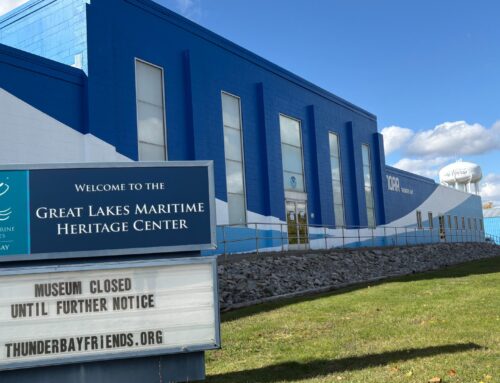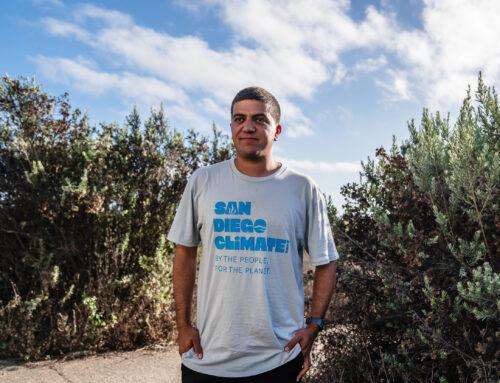Environmental Powerhouse Seeks to Bridge Racial, Class Divide in South County
October 21, 2025
A sunny Friday afternoon in Imperial Beach, and Charles Rilli, deputy director of the Sierra Club’s San Diego chapter, worked the room.
It was minutes before an Oct. 3 panel discussion about the Tijuana River at a crowded state park visitor center. Rilli, 27, chatted with fellow environmental activists, huddled with volunteers and herded audience members to their seats.
He brimmed with the nervous energy of someone eager to see an event he’d helped to plan succeed.
The Sierra Club hired Rilli two years ago with a mandate to boost the Club’s anemic membership in majority-Latino South San Diego County. Events like the river panel, he said, are crucial to meeting that goal.
“In South County, there’s not as much opportunity for engagement with the outdoors,” Rilli said. “It’s critical we meet people where they are.”

Though the Sierra Club is one of America’s oldest, largest and most influential environmental organizations, and though South San Diego County has some of the region’s fastest growing communities and worst environmental problems, fewer than 10 percent of the Club’s 13,000 San Diego County members currently live south of downtown San Diego.
There is no South County equivalent to the Club’s North County local chapter subgroups. None of the Club’s senior San Diego leaders lives in South County. And, until recently, the club was not a major voice in many of the region’s most high-profile environmental debates, including the Tijuana River sewage crisis.
Rilli said it’s his job to fix such problems. “We’re trying to open up opportunities around San Diego County,” he said.
It hasn’t been easy.
“Mobilizing members here is hard,” Rilli said. “People of working-class communities try their best to get by and support their families and have a home and a life and are very family oriented. [Environmental issues often are] not their focus…We have to reframe environmental issues as economic issues.”
Research shows that non-white Americans suffer disproportionately from environmental injustice and broadly support stronger action to combat climate change.
But those same voters shifted to the right in last year’s presidential election, both nationally and in majority-Latino South San Diego County. Last summer, South County voters came close to putting a Republican on the San Diego County Board of Supervisors.
Environmental organizations nationwide have struggled to respond to such contradictory political trends. The Sierra Club’s own efforts to diversify its membership and take on causes relevant to working-class Americans have resulted in a bitter internal debate over the organization’s leadership and future direction.
In 2022, San Diego-area environmental leader Richard Halsey publicly split from the club, accusing Club leaders in an open letter of abandoning traditional environmental goals in favor of social activism and “sham[ing] those who do not align with [the Club’s] opinions on divisive cultural issues.”
Statewide, the Club’s membership has declined by nearly a fifth since 2019. During that same period, the San Diego chapter lost roughly 2,000 members. Just 1,200 of the chapter’s current 13,000 members live in South San Diego County.

Mark West, the San Diego chapter’s new executive director, said fixing the chapter’s demographic and regional imbalances is essential to ensuring not only the chapter’s ongoing relevance but also its survival.
“We, like many organizations, are dealing with our population aging,” West said. “That doesn’t mean they’re not doing fantastic work. We need to get more people involved doing more.”
West said one key to stemming the chapter’s decline is boosting its membership in South San Diego County.
“We don’t feel like we have been represented” in South County, West said.
Rilli said his job has two parts. He must recruit members who might never have thought of themselves as environmentalists. And he must ensure the Club is involved in issues that previously weren’t a top priority for members living north of Interstate 8.
North County members traditionally have focused on issues such as slowing the growth of residential housing, preserving open space and fighting climate change, Rilli said.
South County residents, by contrast, are more worried about air quality, sewage pollution and boosting access to parks and affordable housing, he said.
“The [2024] election showed that economic issues are forefront for people,” Rilli said.
Rilli said his own story shows how working-class people often come to environmental awareness in roundabout ways.
Born into an immigrant family in New Jersey with roots in the Dominican Republic, Rilli said he became interested in environmental activism after witnessing flooding and other effects from rising ocean levels while attending college in southern Florida.
A few years after graduating, he got a job going door-to-door in the working-class New York City borough of Queens. His task: Build support for a curbside composting program.
Queens residents, Rilli discovered, warmed to the idea of composting not when he told them it was good for the environment but when he pointed out that putting food waste in plastic bins could help cut down on the city’s out-of-control rat problem.
“It’s a mistake when people with [environmental] campaigns go to someone’s door and tell them how to do something,” Rilli said. “You need to understand where they’re coming from and what their concerns are.”
Rilli said one of his first tasks after moving to San Diego to work for the Sierra Club in 2023 was figuring out which issues mattered most to South County residents. While the club’s San Diego chapter has worked in recent years to block or soften the environmental impact of several South County housing projects, Rilli said the chapter “did not have the bandwidth to organize people or work on environmental justice issues” in the region.
Rilli embarked on an extended listening tour. He attended city meetings, met with local environmental groups and held outdoor gatherings for the club’s existing South County members.

People he talked to repeatedly mentioned the same handful of issues: Sewage in the Tijuana River, a proposed landfill in Otay Mesa, air pollution in neighborhoods near the Port of San Diego and lack of access to parks and other outdoor spaces.
Rilli urged the Club to make the Tijuana River its top South County priority. He became a regular presence at Imperial Beach City Council meetings, where he built a relationship with then-Mayor Paloma Aguirre (who now represents South San Diego County on the County Board of Supervisors).
He met with community leaders in Coronado and attended meetings of the federal agency that treats cross-border sewage in the Tijuana River Valley.
Judging by the Oct. 3 climate change panel, Rilli appears to have succeeded in putting South County issues on the Sierra Club’s agenda and making the Club more visible at South County environmental events.
Less clear is whether those efforts are making the Club more relevant to average South County residents.
Though the Oct. 3 climate event was well attended, few attendees appeared to be South County natives. Many were affiliated with regional or national environmental organizations headquartered outside the area.
One attendee, a self-described “eco-psychologist” named Shawna Weaver, said she formerly lived in San Diego but now works as a sustainability officer for the city of Duluth, Minnesota. Weaver said she had returned to San Diego to speak at another Climate Week panel on research she had conducted in San Diego on coping with feelings of grief caused by climate change.
With the prominent exception of Aguirre, most speakers on the Tijuana River panel likewise were not South County residents. Two panelists formerly lived in the area, but the rest were from regional organizations such the San Diego Foundation and the Kumeyaay Nation.
After the panel, guests lingered with drinks in hand and snacked on a catered spread of artisanal breads, cheeses, fruit and wraps. A row of nearby tables offered information about organizations such as the Oceanside-based zero-waste nonprofit Sustainability is Sexy.
It was hard not to contrast the event with another environmental event that took place two weeks earlier in National City.
There, dozens of residents, many of them Spanish speakers, packed a city Planning Commission meeting to oppose a Texas-based energy company’s proposal to build a diesel fuel transfer station near homes and a school on the city’s industrial west side.
Virtually all the protesters at the meeting were from National City or nearby communities. They fueled up on boxes of Little Caesars pizza, staged a noisy march around National City Hall and lined up to urge planning commissioners to oppose the transfer station project – which they did by a 4-1 vote.
Organized by the National City-based Environmental Health Coalition, the event seemed to suggest that working-class South County residents respond most readily to environmental appeals not based on larger issues such as climate change but when they sense an environmental injustice or an imminent threat to their neighborhoods or livelihoods.
As one protester said: “We’re gathered here today to let the city know we do not want any more polluting businesses in National City.”
Rilli said he knows he needs to bridge multiple divides to make South County a truly integral part of the Sierra Club’s San Diego agenda.
The Club may even have to expand its definition of the outdoors itself, he said.
Many South County residents can’t afford the kinds of outdoor activities, such as skiing or backpacking, that many Sierra Club members cherish, Rilli said. For working-class people, he said, a picnic in the park with family is often a favorite way to spend time outside.
“The Sierra Club is adjusting its understanding of what counts as outdoor experiences,” Rilli said. “That’s critical to grow the environmental movement and create programming and events that people want to go to.”
Rilli said such conceptual changes can be hard. But he said new ideas are essential to ensuring the environmental movement remains vital in a changing America.
“I think that part of my job is definitely to reframe what environmental issues look like in people’s communities,” he said. “We have to have it so it’s not the same conservation people or climate people who come to our events. We need to widen it for people who see it as a justice issue or economic issue or something that will impact their lives on a day-to-day basis.”
Search
RECENT PRESS RELEASES
Related Post



